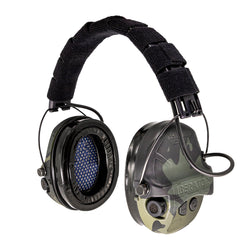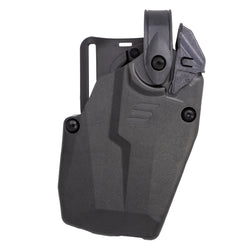Do you have good hearing protection, like the DEHP TCI Electronic Hearing, as part of your training gear? As you start collecting gear for the range, training, home defense, or whatever you need, the list gets long. The rifle, handgun, mags, ammo and such are kind of obvious. But even equipping those with an optic, light, etc. can be a headache. After that, you move on to other gear. Hearing protection, lights, vest carrier, night vision, and, well you get the point.
When I went down this road, I realized very quickly that I needed to prioritize my gear list between “wanted” and “needed.” This is hard to do because most of us want far more gear than we need. But one thing every gun owner needs (besides the gun) is hearing protection. If you train a lot and don’t use good hearing protection, it won’t be long before you don’t need it at all…
With some of your gear, it’s perfectly fine to start with a “budget” friendly option and upgrade later down the road. I rather enjoy finding products that are good quality without costing an arm and a leg. But when it comes to your years, it’s best not to skimp.
I have used the Liberator HP 2.0 hearing protection for a while but wanted to try out the DHP TCI Digital set to see how they compared. So, let’s jump right into and see how this pair stacks up against others on the market.
DEHP TCI Electronic Hearing Protection
The DEHP is engineered to serve the core mission of hearing protection: stopping harmful impulse noise while preserving and even enhancing ambient sound. Built on Safariland’s Version-6 digital technology, this headset delivers serious performance right out of the box.
Features and Engineering
Today, digital earmuffs are becoming more of a standard than a specialty piece of gear. You can buy some very affordable electronic earmuffs, but it’s the quality that sets them apart. And by quality, I mean high decibel suppression, low decibel magnification, and overall comfort. If any of those three things are not performing well, you will be at a disadvantage on the range.

The DEHP system uses Digital Threat Compression to instantaneously shut down hazardous noises, like gunfire. It uses Digital Situational Awareness Enhancement (DSEA) so you can hear voices and environmental cues. They have a noise reduction rating (NRR) of 21dB. They also have extremely clear sound processing capabilities.
Unlike cheaper units that “clip” or cut off sounds abruptly, I’ve found the DEHP has an extremely clear audio response. It sounds natural and easy to hear, even when firing. To achieve this, the company used two separate, well-shielded ambient sound microphones for directional sound detection.
This is one of the things you will notice between good and mediocre earmuffs. With some cheaper sets, any sound is amplified in both ears at the same level. This makes it impossible to tell where the sound came from. With the DEHP TCI earmuffs however, you can easily tell where the sound is coming from.
Overall size and battery life
Another important feature is the overall size of the earmuffs. The earcup profile on the DEHP set is specifically designed to be low-profile. This is important because you need a proper cheek-weld when positioning a rifle. It’s also important if you plan to use them under a helmet. When ordering, you can choose between over the head or behind the head suspension options. Because I already have hearing protection attached to my helmets, I chose the over the head option.
Besides the sound suppression, quality of sound, and the comfort, battery life is another thing to pay attention to. Some earmuffs out there will eat through batteries in just a few hours. It’s not fun trying to change out your batteries in the middle of training.

Battery life is one of DEHP’s most impressive features. They operate on two standard AAA batteries for an impressive 600 hours of battery life. I’ll admit right now, I didn’t believe this when I read it. With most of my other electronic earmuffs, I’m lucky to get one long range day out of the batteries.
But I started taking this pair to the range every time I went, and I haven’t been able to run them down yet. I’m sure how many hours I have on them, but it’s in the three-digit range.
To help with battery life, they also have an automatic shut-off feature. When the battery life falls below 40 hours, you hear an audible warning sound.
Changing the battery: Not my favorite feature
There is the only one thing I’ve discovered on the DEHP TCI earmuffs that I don’t like. Instead of having an opening for both batteries to slide into, there is one opening that is one battery deep. This means you must slide the first battery into the compartment and then push it out of the way, into an internal compartment. This leaves room for the second battery to slide in.

Once you push the first battery into the internal compartment, you can no longer see it. This makes it hard to get back out when changing them. I was able to get the first battery out using a small flat screwdriver, but it took me a minute. There may be an easier way that I don’t know about, but the instructions didn’t really get into removing the batteries.
On a positive note, however, the batteries don’t really need to be changed that often because they last for 600 hours.
Comparison: DEHP TCI vs. Liberator HP 2.0
I mentioned above that I use the Liberator HP 2.0 ear muffs a great deal. These are probably the best electronic earmuffs to compare the DEHP set to.
When it comes to comfort, both pair have gel ear cushions and are extremely comfortable to wear all day. There are really three main categories that set these two pairs of electronic earmuffs apart: protection level, battery flexibility, and digital functionality.

The Key Differences
- Level of Protection (NRR): This is the most significant performance difference. The Liberator HP 2.0 provides an NRR of 26dB, and DEHP offers 21dB. If your environment involves extreme or sustained high-decibel noise, the Liberator 2.0 offers a little better passive protection.
- Digital Functionality & Modes: The Liberator HP 2.0 also has the most adaptability. It offers three distinct hearing modes:
- Enhanced Mode: Like the DEHP, blocks impulse noise and enhances speech.
- Move Mode: Blocks all external noise (useful in high-wind or vehicle transport).
- Clarity Mode: Blocks all external noise while maximizing voice clarity. The DEHP is a robust one-mode solution; the Liberator 2.0 is a versatile, multi-mode platform.
The DEHP TCI pair are simpler in that category and have an on/off button and a volume up and down button. I rarely ever use the other modes on the Liberators, so this feature doesn’t really influence me one way or the other.
- Battery Life: As we already know, DEHP offers an incredible 600-hour run time on two AAA batteries. But the batteries are hard to change. The Liberator HP 2.0 has a quick-change compartment making this process extremely easy, and a battery life of about 300 hours.
The Verdict
Both of these electronic earmuffs are stand-alone units and do not have an AUX input jack. You cany purchase the DEHP’s for about $199 and the Liberators run about $350.
When it comes to comfort, both pairs felt the same to me. They are among the most comfortable earmuffs I’ve used. Clarity and sound felt the same to me, even though the Liberators have a higher sound reduction rating. With the Liberators you get more functioning options and with the DEHP’s you get simplicity and a longer battery life.
Compared to just about every other pair of cheaper electronic hearing I’ve used in the past, the DEHP TCI set is easily the better choice. They are high quality, comfortable and easy to use. If you want more options and a faster battery change, the Liberators are a great step up from there.









